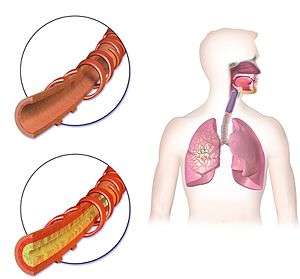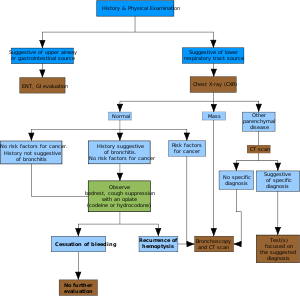Hemoptysis
Hemoptysis is the coughing up of blood or blood-stained mucus from the bronchi, larynx, trachea, or lungs. In other words, it is the airway bleeding. This can occur with lung cancer, infections such as tuberculosis, bronchitis, or pneumonia, and certain cardiovascular conditions. Hemoptysis is considered massive at 300 mL (11 imp fl oz; 10 US fl oz). In such cases, there are always severe injuries. The primary danger comes from choking, rather than blood loss.[1]
| Hemoptysis | |
|---|---|
| Other names | Haemoptysis, coughing up of blood |
 | |
| Frequently hemoptysis bronchitis is indicated. Lower left: Inflammation of the bronchus can bring about bloody mucus. | |
| Pronunciation |
|
| Specialty | Pulmonology |
| Symptoms | Coughing up blood or bloody sputum |
| Causes | Bronchitis, lung cancer |
Diagnosis

- Past history, history of present illness, family history
- history of tuberculosis, bronchiectasis, chronic bronchitis, mitral stenosis, etc.
- history of cigarette smoking, occupational diseases by exposure to silica dust, etc.
- Blood
- duration, frequency, amount
- Amounts of blood: large amounts of blood, or is there blood-streaked sputum
- Probable source of bleeding: Is the blood coughed up, or vomited?
- Bloody sputum
- color, characters: blood-streaked, fresh blood, frothy pink, bloody gelatinous.
- Accompanying symptoms
- fever, chest pain, coughing, purulent sputum, mucocutaneous bleeding, jaundice.
- Imaging examination
- chest X-ray, CT scan and 3D reconstruction images or CT virtual bronchoscopy, bronchial angiography.
- Laboratory tests
- blood test: WBC
- Sputum: cells and bacterial examinations, sputum culture
- Bronchial fiber endoscopy[2]
Differential diagnosis
The most common causes for hemoptysis in adults are chest infections such as bronchitis or pneumonia.[1] In children, hemoptysis is commonly caused by the presence of a foreign body in the airway. Other common causes include lung cancers and tuberculosis. Less common causes include aspergilloma, bronchiectasis, coccidioidomycosis, pulmonary embolism, pneumonic plague, and cystic fibrosis. Rarer causes include hereditary hemorrhagic telangiectasia (HHT or Rendu-Osler-Weber syndrome), Goodpasture's syndrome, and granulomatosis with polyangiitis. A rare cause of hemoptysis in women is endometriosis, which leads to intermittent hemoptysis coinciding with menstrual periods.[3] Hemoptysis may be exacerbated or even caused by overtreatment with anticoagulant drugs such as warfarin.
Blood-laced mucus from the sinus or nose area can sometimes be misidentified as symptomatic of hemoptysis (such secretions can be a sign of nasal or sinus cancer, but also a sinus infection). Extensive non-respiratory injury can also cause one to cough up blood. Cardiac causes like congestive heart failure and mitral stenosis should be ruled out.
The origin of blood can be identified by observing its color. Bright-red, foamy blood comes from the respiratory tract, whereas dark-red, coffee-colored blood comes from the gastrointestinal tract. Sometimes hemoptysis may be rust-colored.
- Lung cancer, including both non-small cell lung carcinoma and small cell lung carcinoma.[4][5]
- Sarcoidosis[6]
- Aspergilloma[7]
- Tuberculosis[8]
- Histoplasmosis[9]
- Pneumonia
- Pulmonary edema
- Foreign body aspiration and aspiration pneumonia
- Goodpasture's syndrome[10]
- Microscopic polyangiitis
- Granulomatosis with polyangiitis[11]
- Eosinophilic granulomatosis with polyangiitis
- Bronchitis[12]
- Bronchiectasis[12]
- Pulmonary embolism[13]
- Anticoagulant use[13]
- Trauma[13]
- Lung abscess[13]
- Mitral stenosis
- Tropical eosinophilia
- Bleeding disorders
- Hughes-Stovin syndrome and other variants of Behçet's disease
- Pulmonary arteriovenous malformations
Treatment
Treatment depends on the underlying cause. Treatments include iced saline, and topical vasoconstrictors such as adrenalin or vasopressin. Tranexamic acid was proved to improve in-hospital mortality.[14] Selective bronchial intubation can be used to collapse the lung that is bleeding. Also, endobronchial tamponade can be used. Laser photocoagulation can be used to stop bleeding during bronchoscopy. Angiography of bronchial arteries can be performed to locate the bleeding, and it can often be embolized.[15] Bronchial artery embolization (BAE) is the first line treatment nowadays.[16][17][18][19][20] Surgical option is usually the last resort and can involve removal of a lung lobe or removal of the entire lung. Cough suppressants can increase the risk of choking.[1]
References
- Sabatine MS (2014). Pocket medicine (Fifth ed.). [S.l.]: Aspen Publishers, Inc. ISBN 978-1451193787.
- Richard F.LeBlond (2004). Diagnostics. US: McGraw-Hill Companies, Inc. ISBN 978-0-07-140923-0.
- Rousset P, Rousset-Jablonski C, Alifano M, Mansuet-Lupo A, Buy JN, Revel MP (March 2014). "Thoracic endometriosis syndrome: CT and MRI features". Clinical Radiology. 69 (3): 323–30. doi:10.1016/j.crad.2013.10.014. PMID 24331768.
- Google Health – Google
- Google Health – Google
- "Sarcoidosis Signs & Symptoms – Sarcoidosis – HealthCommunities.com". Archived from the original on 2009-02-21. Retrieved 2010-02-05.
- MedlinePlus Encyclopedia: Pulmonary aspergilloma
- Google Health – Google
- "Histoplasmosis Symptoms – Diseases and Conditions – Mayo Clinic". Archived from the original on 2013-05-31. Retrieved 2010-02-05.
- Pediatric Goodpasture Syndrome at eMedicine
- "Granulomatosis with Polyangiitis". www.mayoclinic.org. Mayo Foundation for Medical Education and Research. Archived from the original on 22 December 2017. Retrieved 3 March 2018.
- "Hemoptysis Causes – Hemoptysis – HealthCommunities.com". Archived from the original on 2009-01-23. Retrieved 2010-02-05.
- "Other Causes of Hemoptysis – Hemoptysis – HealthCommunities.com". Archived from the original on 2009-06-08. Retrieved 2010-02-05.
- Kinoshita, Takahiro; Ohbe, Hiroyuki; Matsui, Hiroki; Fushimi, Kiyohide; Ogura, Hiroshi; Yasunaga, Hideo (December 2019). "Effect of tranexamic acid on mortality in patients with haemoptysis: a nationwide study". Critical Care. 23 (1): 347. doi:10.1186/s13054-019-2620-5. ISSN 1364-8535. PMC 6836388. PMID 31694697.
- Uppsala Academic Hospital > Guidelines for treatment of acute lung diseases. August 2004. Authors: Christer Hanson, Carl-Axel Karlsson, Mary Kämpe, Kristina Lamberg, Eva Lindberg, Lavinia Machado Boman, Gunnemar Stålenheim
- Woo S, Yoon CJ, Chung JW, Kang SG, Jae HJ, Kim HC, et al. (November 2013). "Bronchial artery embolization to control hemoptysis: comparison of N-butyl-2-cyanoacrylate and polyvinyl alcohol particles". Radiology. 269 (2): 594–602. doi:10.1148/radiol.13130046. PMID 23801773.
- Ishikawa H, Hara M, Ryuge M, Takafuji J, Youmoto M, Akira M, et al. (February 2017). "Efficacy and safety of super selective bronchial artery coil embolisation for haemoptysis: a single-centre retrospective observational study". BMJ Open. 7 (2): e014805. doi:10.1136/bmjopen-2016-014805. PMC 5318547. PMID 28213604.
- Ryuge M, Hara M, Hiroe T, Omachi N, Minomo S, Kitaguchi K, et al. (February 2019). "Mechanisms of recurrent haemoptysis after super-selective bronchial artery coil embolisation: a single-centre retrospective observational study". European Radiology. 29 (2): 707–715. doi:10.1007/s00330-018-5637-2. PMC 6302874. PMID 30054792.
- Panda, Ananya; Bhalla, Ashu Seith; Goyal, Ankur (2017-07-07). "Bronchial artery embolization in hemoptysis: a systematic review". Diagnostic and Interventional Radiology. 23 (4): 307–317. doi:10.5152/dir.2017.16454. PMC 5508955. PMID 28703105.
- Olsen, Kathryn M.; Manouchehr-pour, Shawdi; Donnelly, Edwin F.; Henry, Travis S.; Berry, Mark F.; Boiselle, Phillip M.; Colletti, Patrick M.; Harrison, Nicholas E.; Kuzniewski, Christopher T.; Laroia, Archana T.; Maldonado, Fabien (May 2020). "ACR Appropriateness Criteria® Hemoptysis". Journal of the American College of Radiology. 17 (5): S148–S159. doi:10.1016/j.jacr.2020.01.043.
External links
| Classification | |
|---|---|
| External resources |
- Corey, Ralph (1990). Hemoptysis. Clinical Methods: The History, Physical, and Laboratory Examinations. Butterworths. ISBN 9780409900774. Retrieved 26 June 2018.